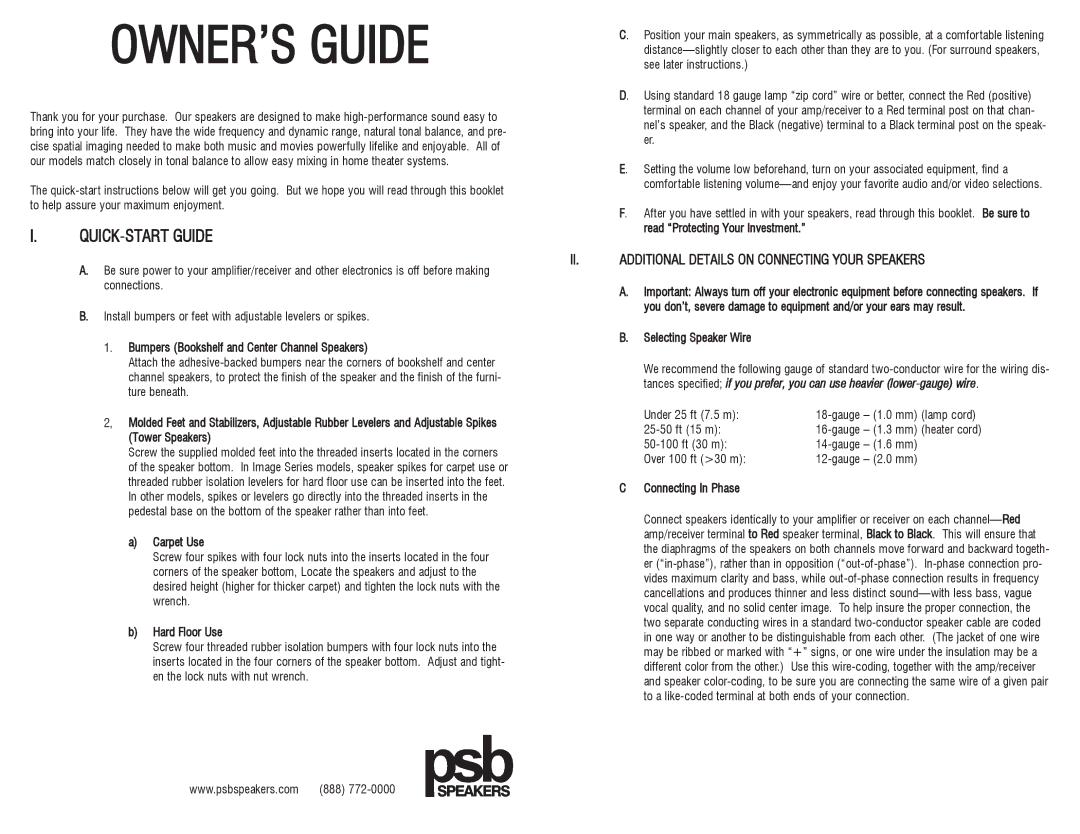
OWNER’S GUIDE
Thank you for your purchase. Our speakers are designed to make
The
I.QUICK-START GUIDE
C. Position your main speakers, as symmetrically as possible, at a comfortable listening
D. Using standard 18 gauge lamp “zip cord” wire or better, connect the Red (positive) terminal on each channel of your amp/receiver to a Red terminal post on that chan- nel’s speaker, and the Black (negative) terminal to a Black terminal post on the speak- er.
E. Setting the volume low beforehand, turn on your associated equipment, find a comfortable listening
F. After you have settled in with your speakers, read through this booklet. Be sure to read “Protecting Your Investment.”
A. | Be sure power to your amplifier/receiver and other electronics is off before making | II. | ADDITIONAL DETAILS ON CONNECTING YOUR SPEAKERS | ||
|
|
|
| ||
| connections. |
| A. | Important: Always turn off your electronic equipment before connecting speakers. If | |
|
|
| |||
B. | Install bumpers or feet with adjustable levelers or spikes. |
|
| you don’t, severe damage to equipment and/or your ears may result. | |
|
|
|
| ||
| 1. Bumpers (Bookshelf and Center Channel Speakers) |
| B. Selecting Speaker Wire |
| |
|
|
|
|
| |
| Attach the |
|
| We recommend the following gauge of standard | |
| channel speakers, to protect the finish of the speaker and the finish of the furni- |
|
| ||
|
|
| tances specified; if you prefer, you can use heavier | ||
| ture beneath. |
|
| ||
|
|
|
|
| |
| 2, Molded Feet and Stabilizers, Adjustable Rubber Levelers and Adjustable Spikes |
|
| Under 25 ft (7.5 m): | |
|
|
| |||
| (Tower Speakers) |
|
| ||
|
|
| |||
| Screw the supplied molded feet into the threaded inserts located in the corners |
|
| ||
|
|
| Over 100 ft (>30 m): | ||
| of the speaker bottom. In Image Series models, speaker spikes for carpet use or |
|
| ||
|
|
|
|
| |
| threaded rubber isolation levelers for hard floor use can be inserted into the feet. |
| C | Connecting In Phase |
|
| In other models, spikes or levelers go directly into the threaded inserts in the |
|
| ||
|
|
|
|
| |
| pedestal base on the bottom of the speaker rather than into feet. |
|
| Connect speakers identically to your amplifier or receiver on each | |
|
|
|
| ||
| a) Carpet Use |
|
| amp/receiver terminal to Red speaker terminal, Black to Black. This will ensure that | |
|
|
| the diaphragms of the speakers on both channels move forward and backward togeth- | ||
| Screw four spikes with four lock nuts into the inserts located in the four |
|
| ||
|
|
| er | ||
| corners of the speaker bottom, Locate the speakers and adjust to the |
|
| ||
|
|
| vides maximum clarity and bass, while | ||
| desired height (higher for thicker carpet) and tighten the lock nuts with the |
|
| ||
|
|
| cancellations and produces thinner and less distinct | ||
| wrench. |
|
| ||
|
|
| vocal quality, and no solid center image. To help insure the proper connection, the | ||
|
|
|
| ||
| b) Hard Floor Use |
|
| two separate conducting wires in a standard | |
|
|
| in one way or another to be distinguishable from each other. (The jacket of one wire | ||
| Screw four threaded rubber isolation bumpers with four lock nuts into the |
|
| ||
|
|
| may be ribbed or marked with “+” signs, or one wire under the insulation may be a | ||
| inserts located in the four corners of the speaker bottom. Adjust and tight- |
|
| ||
|
|
| different color from the other.) | Use this | |
| en the lock nuts with nut wrench. |
|
| ||
|
|
| and speaker | ||
|
|
|
| ||
to a
www.psbspeakers.com | (888) |
